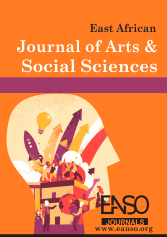Pre-Iconographic Description of Evil in The Lion Guard
Abstract
This study delves into the pre-iconographical analysis of elements that define evil in the film The Lion Guard. This study explores how the filmmakers use fundamental visual and auditory cues such as character appearance, environmental settings, and symbolic objects to identify and describe evil. The analysis focuses on three key areas: the Appearance of Evil, manifested through the sinister physical traits and possessions of antagonists like Scar and Zira; the Image of Chaos and the Human Quest for Power, revealed through the desolate landscapes of the Outlands; and the archetype of Women as Evil Doers, which is examined through the manipulative and vengeful actions of female villains. The paper argues that these observable markers are not just decorative but are crucial to the film’s narrative, making abstract concepts of disruption, immorality, and ambition tangible for the audience
Downloads
References
Boano, C. (2011). Urban voids and the architectural imagination of emptiness. GeoJournal, 76(4), 303–318.
Bordwell, D., & Thompson, K. (2012). Film art: An introduction (10th ed.). McGraw-Hill.
Croley, N. (2017). Monstrous bodies: The portrayal of evil through physical characteristics in film [Master’s thesis, Central Michigan University]. ProQuest Dissertations Publishing.
D’Adamo, D. T. (2018). Deathstarchitecture: The space of evil. Kinephanos. https://www.kinephanos.ca/Revue_files/2018_D%27Adamo.pdf
Doğru, M. S. (2016, October). Light as an instrument of visual metaphor and expression in cinema productions: The example of film noir [Conference paper]. The 2nd International Conference on the Changing World and Social Research.
Hundertmark, J. (2022). ‘Both hero and villain’ – Rewriting the tale, revising the villain, and retelling gender in Disney’s Maleficent (2014). Limina, 26(2), 1–18. The Limina Editorial Collective. https://doi.org/10.53929/1037833
Innemée, K. C., & Zielińska, D. (2019). Faces of evil in Nubian wall-painting – An overview. Études et Travaux (Institut des Cultures Méditerranéennes et Orientales de l’Académie Polonaise des Sciences), 32, 121–144.
Kurtz, L. R. (2007). Gods in the global village: The world’s religions in sociological perspective (3rd ed.). Pine Forge Press.
Martínez-Oña, M. M., & Muñoz-Muñoz, A. M. (2015). An iconographic analysis of the myth of Lilith in advertising. Revista Latina de Comunicación Social, 70, 611–626. https://doi.org/10.4185/RLCS-2015-1062en
Milton, J. (2003). Paradise lost. Modern Library.
Panofsky, E. (1939). Studies in iconology: Humanistic themes in the art of the Renaissance. Oxford University Press.
Panofsky, E. (1972). Studies in iconology: Humanistic themes in the art of the Renaissance. Harper & Row. (Original work published 1939)
Priti, A. (2010). The bad girl archetype: A study of female villains in Disney and Pixar animated films [Master’s thesis, Columbia University]. ProQuest Dissertations Publishing.
Rigopoulos, A. (2014). The construction of a cultic center through narrative: The founding myth of the village of Puttaparthi and Sathya Sāī Bābā. History of Religions, 54(2), 117–150. https://doi.org/10.1086/678123
The nature of violence: An essay for Collier’s Year Book, 1969. (1969). In Microsoft Encarta [DVD]. Microsoft Corporation.
Wyman, K. J. (2004). The devil we already know: Medieval representations of a powerless Satan in modern American cinema. Journal of Religion & Film, 8(3), Article 7. https://doi.org/10.32873/uno.dc.jrf.08.03.07
Copyright (c) 2025 Eunice Samwel, George Obara Nyandoro, PhD, Bwocha Nyagemi, PhD, Abu Bakar, PhD

This work is licensed under a Creative Commons Attribution 4.0 International License.




























